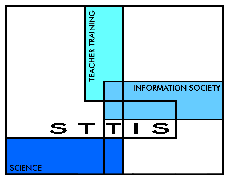
Science Teacher Training
in an Information Society
 Teaching about energy
Teaching about energy

 |
Science Teacher Training
in an Information Society |
 |
Workshop 1
|
Aims
BackgroundThe first part of this activity draws the similarity between pulling a spring and lifting something away from the Earth. It develops the idea that 'pulling apart' changes do not 'just happen' but that the opposite change does. However, when we say that these changes 'just happen' we need to add 'once they have been started' because there may be something preventing the change from happening. (For example, a ball at the top of a hill may need a push before it starts rolling down by itself.)The second part of the activity extends the idea of a ‘spring’, so that fuel/oxygen systems can be thought of as ‘chemical springs’. An important idea here is that energy is released when a fuel reacts with oxygen. A fuel on its own is not a store of energy - a candle would be useless in outer space and a car would not work on the Moon because there is no oxygen. They would be useful as fuels if there was a supply of oxygen as well. (On a planet in which the atmosphere was methane, then oxygen would be a 'fuel'). Fuel burning in oxygen releases energy - this is similar to a spring being released. Another important idea is that a fuel burning is a change that 'just happens'. Children may object to this idea, saying that you need to light it first. They are absolutely right - what we really mean when we say that fuel burning 'just happens' is that it 'just happens once is has been started'. This is just the same idea as giving a ball on a hill a push to start it rolling. What to do1. Read through the OHTs on page 3 and page 4. so the same picture can be used to represent these changes. The similarity between mechanical and ‘gravitational’ springs is emphasised by using the same abstract picture to represent them. In using this activity with pupils, it is useful to discuss examples of other similar changes, e.g. squashing a spring, pulling and releasing a luggage cord or a rubber band, a rocket being fired into space, a falling meteorite.2. Do the activity on page 5. Note that in this activity there is room for interpretation in the matches that could be made. Check your answers against those on page 2. 3. Read the OHT on page 6 which extends these ideas to the burning of fuels, and do the activity on page 7. Check your answers on page 2. 4. Now think back over these activities, and consider the following questions:
|
| <<= Previous page | Introduction to Teachers' Workshop 1 | Next page =>> |